-

新人教版高中英语必修2Unit 4 History and traditions教案
这个地区有着深厚的传统。既学既练:为了让更多的外国游客了解中国文化,欣赏中国美丽的自然风光,感受中国发生的巨大变化,某外文杂志社将出版一本英语小册子来介绍中国的旅游景点。该杂志社邀请你为该小册子写一篇英语短文来介绍杭州,内容包括:1.杭州的位置(中国东南部)、面积(16 000多平方公里)及历史(2 200多年)等;2.杭州的旅游特色(自然风景、传统文化、特色小吃等);3.希望更多的游客来杭州参观。注意:1.词数80左右;2.可适当增加细节,以使行文连贯。Located in the southeast of China, Hangzhou is a beautiful city.Dating back more than 2,200 years, Hangzhou covers an area of more than 16,000 square kilometers.In Hangzhou, you can visit the West Lake, whose scenery is fascinating.In addition, you can’t miss its cultural relics and historical sites, from which you will learn more about excellent Chinese traditional culture and traditions.In Hangzhou, the special snacks are famous and visitors from different parts of the world think highly of them.As a tourist attraction, Hangzhou attracts a large number of visitors from home and abroad every year.Once you come to China, Hangzhou is a scenic spot you can’t miss.

新人教版高中英语必修2Unit 5 Music-Listening&Speaking&Talking教案
choir memberspeople to run food stands people to sell festival ticketspeople to sell music CDspeople to set up equipmentmusical performersStep 2: Listen to the announcement again and answer the questions. ? 1. What kind of songs will Grace Davis sing at the festival?? 2. Who can try out as a performer?? 3. What can those who think they do not have musical talent do?? 4. How can students volunteer to take part?? Talking about preferences:? Would you prefer doing ..?? What would you prefer to do?? Would you rather do .... or ….?? What would you rather do?? I'd prefer .... to ..? I'd rather have ... than .. Step 3: Speaking ProjectWork in groups. Role-play the conversation or make a new one.? Debbie: Where have you been? You missed the announcement about the music festival.? John: I was at the doctor's office. Music festival?? Frank: Yes, it's going to be next month on the school sports field. John, you can play the piano. How about playing it at the festival?? John: Well, I'd rather play the violin. I can play Liang Zhu.? Frank: Wow! Sounds good. What about you, Debbie? ? Debbie: Actually, I don't have much musical ability. I'd prefer just to help out with the crowds.? Frank: You can sell tickets or work at a food stand.? John: So can I assume that the aim of the festival is to raise money?? Debbie: Yes. All of the money will go to charity.

新人教版高中英语必修2Unit 5 Music-Discovering Useful Structures教案一
Step1:自主探究。1.(教材P52)Born(bear) in the USA on 2 January 1970, Whitacre began studying music at the University of Nevada in 1988.2.(教材P52) Moved(move) by this music, he said, “It was like seeing color for the first time.”3.(教材P56)I was very afraid and I felt so alone and discouraged(discourage).4.(教材P58)Encouraged(encourage) by this first performance and the positive reaction of the audience, I have continued to play the piano and enjoy it more every day.Step2:语法要点精析。用法1:过去分词作表语1).过去分词可放在连系动词be, get, feel, remain, seem, look, become等之后作表语,表示主语所处的状态Tom was astonished to see a snake moving across the floor.汤姆很惊讶地看到一条蛇正爬过地板。Finally the baby felt tired of playing with those toys.终于婴儿厌倦了玩那些玩具。注意:1).过去分词作表语时与被动语态的区别过去分词作表语时,强调主语所处的状态;而动词的被动语态表示主语是动作的承受者,强调动作。The library is now closed.(状态)图书馆现在关闭了。The cup was broken by my little sister yesterday.(动作)昨天我妹妹把杯子打碎了。2)感觉类及物动词的现在分词与过去分词作表语的区别过去分词作表语多表示人自身的感受或事物自身的状态,常译作“感到……的”;现在分词多表示事物具有的特性,常译作“令人……的”。

新人教版高中英语必修2Unit 5 Music-Listening and Speaking教案
This lesson is about music. Students can classify the types of music through the instruments and its sound and can talk about their preferences about music, even join some activities and play a role in them according to their musical talents. On the basis, they are guided to use the languages to express their preferences and some plosive sounds and their rules.1. Classify the music types through the instruments and its sound.2. Listen and understand what the speakers’ preferences are and the reasons; talk about their own preferences and give their own reasons, using these sentences: “What kind of music do you like? And why? “ “Because it makes/gives me energy/peaceful.../touches my heart...”.3. Learn some plosives and the rules.4. Join some activities and play a role in them according to the talents. 1. Listen and understand what the speakers’ preferences are and the reasons;2. talk about their own preferences and give their own reasons, using these sentences: “What kind of music do you like? And why? “ “Because it makes/gives me energy/peaceful.../touches my heart...”.3. Learn some plosives and incomplete plosives and its rules.Step 1 Lead inPoint at the pictures on P50 and ask Q1: What are the people doing in the pictures below?Q2: What kind of music they are?Then play the MP3s one by oneStep 2 ListeningTask 1: A reporter from the school newspaper is interviewing students about music. Listen to the interviews. Draw lines between the words to make complete sentences. Some words will not be used.
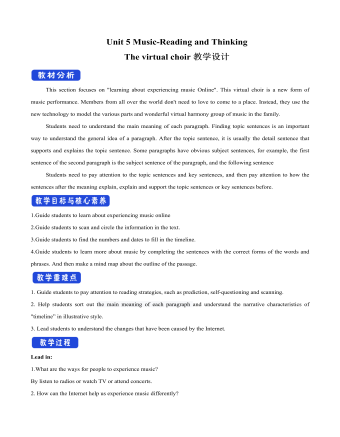
新人教版高中英语必修2Unit 5 Music-Reading and Thinking教案一
This section focuses on "learning about experiencing music Online". This virtual choir is a new form of music performance. Members from all over the world don't need to love to come to a place. Instead, they use the new technology to model the various parts and wonderful virtual harmony group of music in the family. Students need to understand the main meaning of each paragraph. Finding topic sentences is an important way to understand the general idea of a paragraph. After the topic sentence, it is usually the detail sentence that supports and explains the topic sentence. Some paragraphs have obvious subject sentences, for example, the first sentence of the second paragraph is the subject sentence of the paragraph, and the following sentenceStudents need to pay attention to the topic sentences and key sentences, and then pay attention to how the sentences after the meaning explain, explain and support the topic sentences or key sentences before.1.Guide students to learn about experiencing music online2.Guide students to scan and circle the information in the text.3.Guide students to find the numbers and dates to fill in the timeline.4.Guide students to learn more about music by completing the sentences with the correct forms of the words and phrases. And then make a mind map about the outline of the passage.1. Guide students to pay attention to reading strategies, such as prediction, self-questioning and scanning.2. Help students sort out the main meaning of each paragraph and understand the narrative characteristics of "timeline” in illustrative style.3. Lead students to understand the changes that have been caused by the Internet.
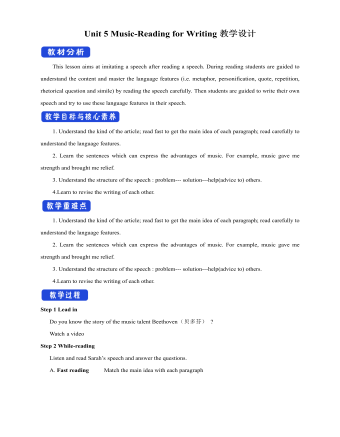
新人教版高中英语必修2Unit 5 Music-Reading for Writing教案二
The Internet celebrity Gao Yifeng. Years ago, he owned 5 companies and the staffs over 1,000, but during the economy crisis, he became nothing but debt. He was so worried that his hair became white overnight. There was a time when he wanted to killed himself. But after listening to the song Start Over by Liu Huan, he decided to cheer himself up. He started a steamed bun shop and gradually became a national chain shops. Now he became successful again.Walter Haddon said, “Music is the medicine of a troubled mind.” Music contains such a pleasant and inspiring force. Music gave him courage and bravery. When he listened to the song, it made his spirit fly like a kite in the wind. Music gave him strength and brought him relief. It was the rock I leant on to become strong and to get through those hard times. I hope none of us have to go through the same kind of suffering that he did. At the same time, we all go through various periods when we feel sad or alone. During those times, music can help us in the same way that it helped him. I hope we all will somehow begin to treasure music and make it a part of our life. Thank you for your listening !5.Revise your writing each other.Does he/she explain how music has changed his/her/someone else’s life?Are some of the rhetorical devices included and used properly ?Does he/she talk about how music makes him/her/someone feel?Is the first word in each sentences capitalised?Does he/she use correct punctuation ?
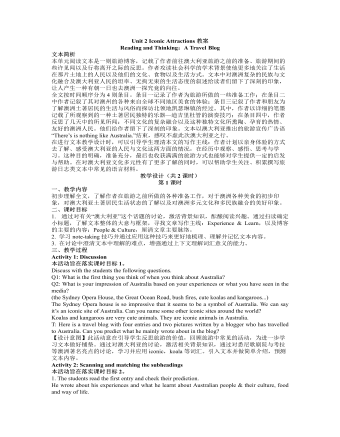
新人教版高中英语选修4Unit 2 Iconic Attractions教案
帮助学生通过讨论与对主题的提升,反思自己的旅游方式,以便做出更优化的安排,在今后的旅程中有更多的收益。 Activity 2: Further discussion of the 6 elements above and supplement of more background knowledge 本活动为实现课时教学目标2。 1.Target Q: The writer’s clear target of traveling, meeting the people and experiencing the culture, is closely related to his major in social studies. Then what is social studies? Social studies is a part of a school or college curriculum concerned with the study of social relationships and the functioning of society and usually made up of courses in history, government, economics, civics, sociology, geography, and anthropology. (Dictionary by Merriam-Webster) Reflection: When you go out to travel, what targets do you usually have in mind? 2.Research Q: Suppose you are traveling to Hangzhou during the school holidays, how will you do research on the city? (surf the internet, read books or travel brochures, consult friends, ...) What information will you be interested to know? (location, iconic sites, local cuisines, interesting customs, shopping malls ...) 3.Abandonment To make the most of time, we have to learn to abandon so that we can accomplish our plan. What will you be interested in doing if you go to Hangzhou if you have a week’s time? What if you only have 2 days? 4~5. Venturing & Experiencing Q: What did he venture to do during the trip? What new experiences did he have? In Sydney: attend his first open-air barbecue, enjoy many different but yummy meals In Catherine: observe the life and customs of the aborigines appreciate their music & try the musical instruments: the didgeridoo

部编人教版五年级下册《人物描写一组》说课稿
二、说教学目标及重难点:1.教学目标 :(1)自主学习字词,会认“噶、绊”等12个生字,会写“搂、仗”等15个生字,理解字义,识记字形。正确读写和理解“手疾眼快、一叉一搂、公鸡鹐架、冷绊子、挺脱、诸亲六眷、监生、一声不倒一声、已后、登时”等词语。(2)正确、流利地朗读课文,体会人物的性格特点,感受小嘎子、车夫、严监生这三个鲜活的人物形象。(3)理解课文内容,学习作者抓住人物的动作、语言、外貌、心理活动等描写人物的方法,学习表现人物某一方面特点的写作方法。(4)激发学生阅读中外名著的兴趣。2.教学重点:体会人物的性格特点,感受小嘎子、车夫、严监生这三个鲜活的人物形象。3.教学难点:学习作者抓住人物的动作、语言、外貌、心理活动等描写人物的方法,学习表现人物某一方面特点的写作方法。

部编人教版五年级下册《童年的发现》说课稿
一、本节课的设计理念: 课题中的“发现”一词是本文的文眼,教学中引导学生从课题入手提出疑问,然后进行梳理明确主要学习任务。学生自主学习,了解“我”发现了什么,重点了解“我”是怎么发现的,理清作者童年时发现胚胎发育规律的过程。二、教材分析:本课是一篇鼓励求知、鼓励大胆想象、鼓励探究发现的课文,通过作者回忆童年时发现胚胎发育规律这件趣事,反映了儿童求知若渴的心理特点和惊人的想象力。第一部分先概述了“我”九岁时发现了有关胚胎发育的规律,却在后来因此受到惩罚。第二部分具体叙述“我”发现有关胚胎发育规律的前后经过。最后,写这个发现在几年后老师讲课时得到证实,“我”情不自禁地笑出了声,结果被老师误解受到处罚,但“我”从中获得感悟。本文故事情节充满童真童趣,语言风趣幽默,并有多处内心活动的描写,真实展现了孩子内心世界。

小学数学人教版五年级下册《质数和合数》说课稿
设计意图:我运用了引导学生探究发现的教学方法,学生采用观察比较、分类归纳、讨论交流的学习方法。因为“质数和合数”是学生在学习了因数和倍数的基础上进行学习的。因此我抓住新旧知识的连接点,让学生找自己座号的因数,从学生身边熟悉的事物入手,唤起学生亲切的情感,激发他们学习的兴趣。学生是学习的主体,只有让学生参与知识的形成过程,数学知识才会内化学生自己的东西,四人小组讨论交流就是让学生在探讨中提高学习的能力。5、科学总结 实战练习(1)基本练习。完成“做一做”。 (2)强化练习。练习四第1、2题。 (3)综合练习。1-80质数表。验证刚才的判断是否正确。师:通过这节课的学习,你又有了什么新的收获? 你能帮甜甜解决箱子密码的问题了吗?
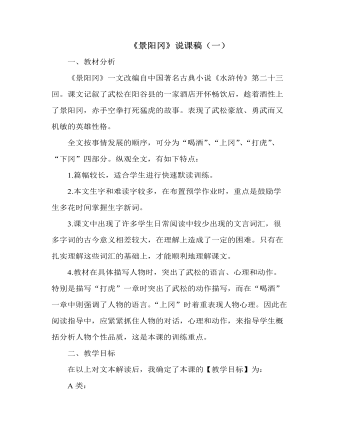
部编人教版五年级下册《景阳冈》说课稿(一)
全文按事情发展的顺序,可分为“喝酒”、“上冈”、“打虎”、“下冈”四部分。纵观全文,有如下特点:1.篇幅较长,适合学生进行快速默读训练。2.本文生字和难读字较多,在布置预学作业时,重点是鼓励学生多花时间掌握生字新词。3.课文中出现了许多学生日常阅读中较少出现的文言词汇,很多字词的古今意义相差较大,在理解上造成了一定的困难。只有在扎实理解这些词汇的基础上,才能顺利地理解课文。4.教材在具体描写人物时,突出了武松的语言、心理和动作。特别是描写“打虎”一章时突出了武松的动作描写,而在“喝酒”一章中则强调了人物的语言。“上冈”时着重表现人物心理。因此在阅读指导中,应紧紧抓住人物的对话,心理和动作,来指导学生概括分析人物个性品质,这是本课的训练重点。

小学数学人教版五年级下册《约分》说课稿
一、说教材《约分》是人教版小学数学五下第四单元的教学内容,在学习约分前,学生已经探索了分数的基本性质,学习了求最大公因数的方法,这些知识的掌握都为约分方法的学习提供了认知基础。教材通过例4,教学约分的一般方法。同时在学生会求两数最大公因数的基础上,启发他们思考,有没有更简便的方法?并介绍了约分时的常用书写形式。二、谈学情这一课的学习对象是五年级的学生,他们一方面具有小学生的特点:对新鲜事物很感兴趣,以形象思维为主,有强烈的表现欲望、好胜心,但是部分学生还不能快速找出两个数的公因数、最大公因数以及快速判断两个数是否互质。 二、说教学目标基于对教材和学情的分析,我们确定了以下教学目标:1.知识目标:理解和掌握约分的意义和方法,掌握最简分数的概念2.能力目标:熟练进行约分,培养灵活运用所学知识解决实际问题的能力。 3.情感目标:引导探索知识间的内在联系,培养学生观察、比较、分析的能力和良好的数学学习习惯。
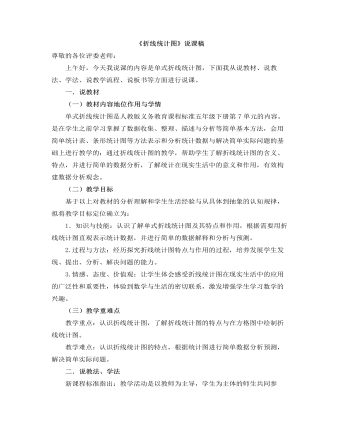
小学数学人教版五年级下册《折线统计图》说课稿
一.说教材(一)教材内容地位作用与学情单式折线统计图是人教版义务教育课程标准五年级下册第7单元的内容。是在学生之前学习掌握了数据收集、整理、描述与分析等简单基本方法,会用简单统计表、条形统计图等方法表示和分析统计数据与解决简单实际问题的基础上进行教学的;通过折线统计图的教学,帮助学生了解折线统计图的含义、特点,并进行简单的数据分析,了解统计在现实生活中的意义和作用,有效构建数据分析观念。(二)教学目标基于以上对教材的分析理解和学生生活经验与从具体到抽象的认知规律,拟将教学目标定位确立为: 1.知识与技能:认识了解单式折线统计图及其特点和作用,根据需要用折线统计图直观表示统计数据,并进行简单的数据解释和分析与预测。 2.过程与方法:经历探究折线统计图特点与作用的过程,培养发展学生发现、提出、分析、解决问题的能力。
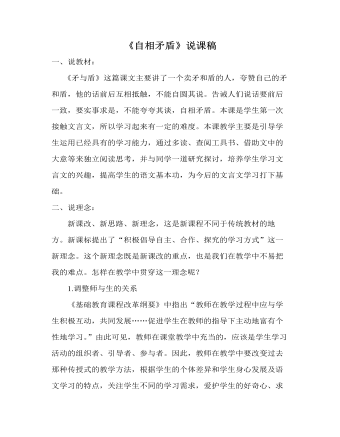
部编人教版五年级下册《自相矛盾》说课稿
三、说教学目标:根据对教材的深入分析,及对学生现状的了解,拟定本课的教学目标为:1.知识目标:(1)正确、流利、有感情地朗读课文。(2)学习本课生字、生词。(3)理解课文内容,知道自相矛盾的含义。2.能力目标:初步了解学习文言文的方法,能通过课文大意弄懂古文的意思。3.情感目标:凭借课文中具体的语言材料,使学生在理解寓意的过程中受到启发教育,能激发学生学习文言文的兴趣。4.教学重难点:(1)引导学生抓住对话中的关键性的话语展开思考、读、讨论。掌握学习文言文的方法。(2)理解古文的意思,弄懂寓言的寓意,并用自己的话表达出来。 四、说教法、学法:教法:紧紧抓住读这个重点,采取: 读通——读懂——读好——读透的“四读法”进行展示交流,以读贯穿整个课堂,让学生在读中感受文言文的语言美、意境美、韵味美,在读中理解文意,在读中明白寓言所揭示的道理。
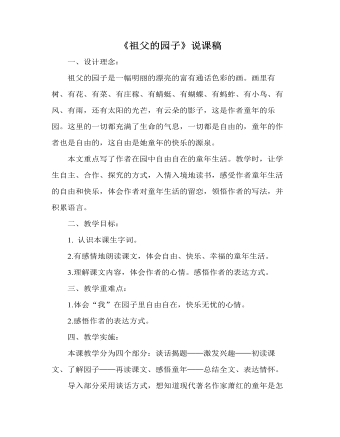
部编人教版五年级下册《祖父的园子》说课稿(二)
一、设计理念:祖父的园子是一幅明丽的漂亮的富有通话色彩的画。画里有树、有花、有菜、有庄稼、有蜻蜓、有蝴蝶、有蚂蚱、有小鸟、有风、有雨,还有太阳的光芒,有云朵的影子,这是作者童年的乐园。这里的一切都充满了生命的气息,一切都是自由的,童年的作者也是自由的,这自由是她童年的快乐的源泉。本文重点写了作者在园中自由自在的童年生活。教学时,让学生自主、合作、探究的方式,入情入境地读书,感受作者童年生活的自由和快乐,体会作者对童年生活的留恋,领悟作者的写法,并积累语言。二、教学目标:1. 认识本课生字词。2.有感情地朗读课文,体会自由、快乐、幸福的童年生活。3.理解课文内容,体会作者的心情。感悟作者的表达方式。
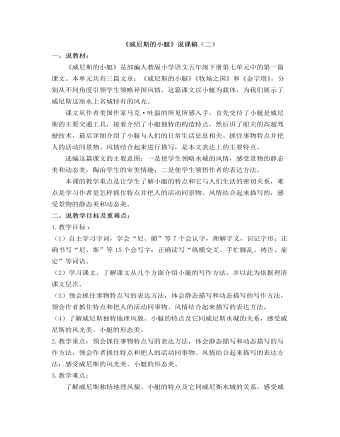
部编人教版五年级下册《威尼斯的小艇》说课稿(二)
四、说教法和学法:1.说教法:在教学过程中激发学生的学习兴趣,为学生创设良好的自主学习情境,充分发挥学生的主动性和积极性,注重培养学生自主学习的意识和习惯,尊重学生的个体差异,倡导自主、合作、探究的学习方式,充分发挥小组教学的优势,充分发挥教师的潜能。所以我采用了“阅读——思考——交流——评议”的教学模式,所谓“阅读——思考”就是独立学习,在教师指导下进行自读自悟;“交流”就是鼓励学生质疑问难,通过读课文提出问题,并尽可能自己解决疑问,让学生通过自身的实践——动脑、动口、动手,获得新知;“评议”就是对别人发言进行评价,也可以提出不同的见解。最终达到培养学生具有感受、理解、欣赏和评价能力的目标。
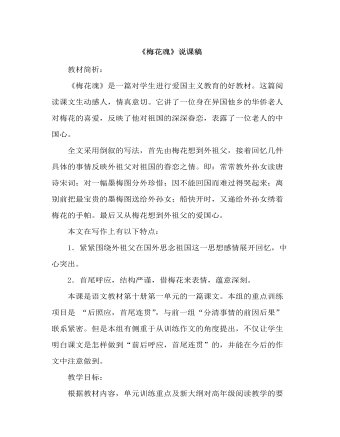
部编人教版五年级下册《 梅花魂》说课稿
全文采用倒叙的写法,首先由梅花想到外祖父,接着回忆几件具体的事情反映外祖父对祖国的眷恋之情。即:常常教外孙女读唐诗宋词;对一幅墨梅图分外珍惜;因不能回国而难过得哭起来;离别前把最宝贵的墨梅图送给外孙女;船快开时,又递给外孙女绣着梅花的手帕。最后又从梅花想到外祖父的爱国心。本文在写作上有以下特点:1.紧紧围绕外祖父在国外思念祖国这一思想感情展开回忆,中心突出。2.首尾呼应,结构严谨,借梅花来表情,蕴意深刻。本课是语文教材第十册第一单元的一篇课文。本组的重点训练项目是 “后照应,首尾连贯”,与前一组“分清事情的前因后果”联系紧密。但是本组有侧重于从训练作文的角度提出,不仅让学生明白课文是怎样做到“前后呼应,首尾连贯”的,并能在今后的作文中注意做到。
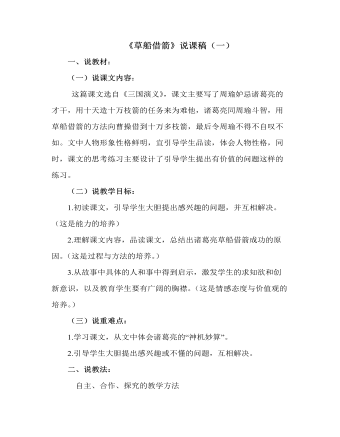
部编人教版五年级下册《草船借箭》说课稿(一)
一、说教材:(一)说课文内容:这篇课文选自《三国演义》,课文主要写了周瑜妒忌诸葛亮的才干,用十天造十万枝箭的任务来为难他,诸葛亮同周瑜斗智,用草船借箭的方法向曹操借到十万多枝箭,最后令周瑜不得不自叹不如。文中人物形象性格鲜明,宜引导学生品读,体会人物性格,同时,课文的思考练习主要设计了引导学生提出有价值的问题这样的练习。(二)说教学目标:1.初读课文,引导学生大胆提出感兴趣的问题,并互相解决。(这是能力的培养)2.理解课文内容,品读课文,总结出诸葛亮草船借箭成功的原因。(这是过程与方法的培养。)3.从故事中具体的人和事中得到启示,激发学生的求知欲和创新意识,以及教育学生要有广阔的胸襟。(这是情感态度与价值观的培养。)
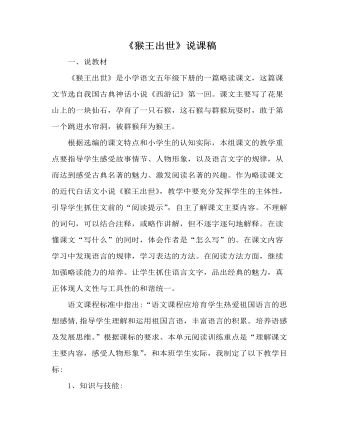
部编人教版五年级下册《猴王出世》说课稿
一、说教材《猴王出世》是小学语文五年级下册的一篇略读课文,这篇课文节选自我国古典神话小说《西游记》第一回。课文主要写了花果山上的一块仙石,孕育了一只石猴,这石猴与群猴玩耍时,敢于第一个跳进水帘洞,被群猴拜为猴王。根据选编的课文特点和小学生的认知实际,本组课文的教学重点要指导学生感受故事情节、人物形象,以及语言文字的规律,从而达到感受古典名著的魅力、激发阅读名著的兴趣。作为略读课文的近代白话文小说《猴王出世》,教学中要充分发挥学生的主体性,引导学生抓住文前的“阅读提示”,自主了解课文主要内容。不理解的词句,可以结合注释,或略作讲解,但不逐字逐句地解释。在读懂课文“写什么”的同时,体会作者是“怎么写”的。在课文内容学习中发现语言的规律,学习表达的方法。在阅读方法方面,继续加强略读能力的培养。让学生抓住语言文字,品出经典的魅力,真正体现人文性与工具性的和谐统一。
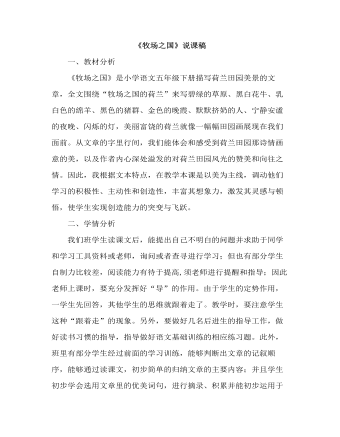
部编人教版五年级下册《牧场之国》说课稿
一、教材分析《牧场之国》是小学语文五年级下册描写荷兰田园美景的文章,全文围绕“牧场之国的荷兰”来写碧绿的草原、黑白花牛、乳白色的绵羊、黑色的猪群、金色的晚霞、默默挤奶的人、宁静安谧的夜晚、闪烁的灯,美丽富饶的荷兰就像一幅幅田园画展现在我们面前。从文章的字里行间,我们能体会和感受到荷兰田园那诗情画意的美,以及作者内心深处溢发的对荷兰田园风光的赞美和向往之情。因此,我根据文本特点,在教学本课是以美为主线,调动他们学习的积极性、主动性和创造性,丰富其想象力,激发其灵感与顿悟,使学生实现创造能力的突变与飞跃。三、目标设计依据四年级儿童特点和教材特色,本着“学语文、用语文”的课研精神,我把《牧场之国》的教学目标确定为:1.通过正确、流利地朗读课文,了解荷兰牧场的特点,感受异国的田园风光。2.通过小组合作提高学生感悟文章语言的生动性,积累语言的能力。

